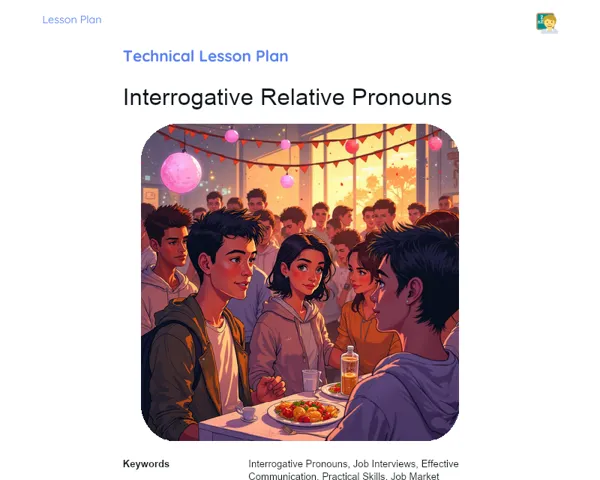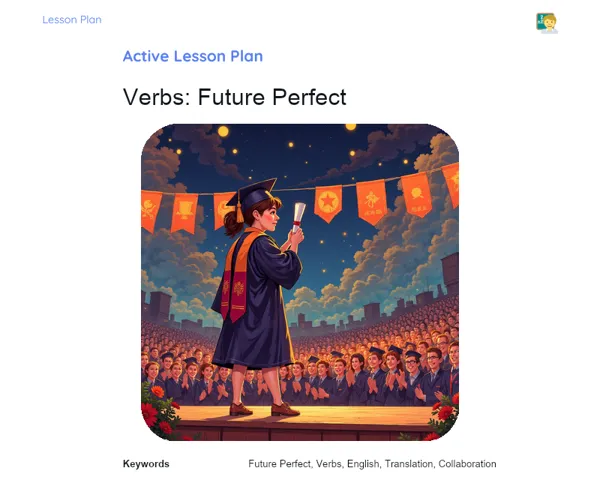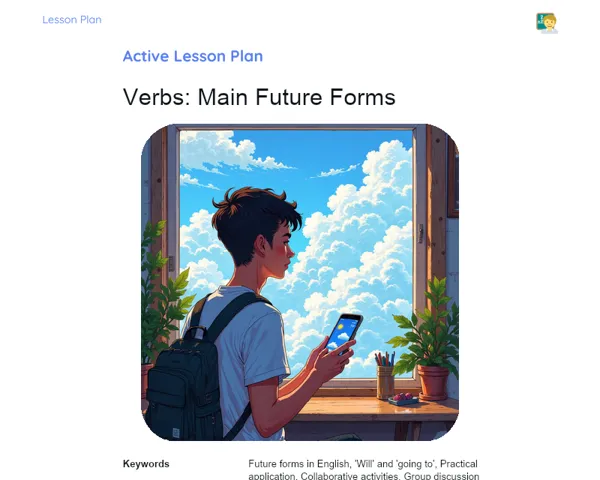Lesson Plan | Socioemotional Learning | Verbs: Present Perfect Continuous
| Keywords | Present Perfect Continuous, Verbs in English, Socioemotional Skills, Self-awareness, Self-regulation, Responsible Decision-Making, Social Skills, Social Awareness, RULER, Guided Reflection, Group Stories, Written Reflection, Personal and Academic Goals |
| Resources | Whiteboard and markers, A4 sheets and pens, Support materials on Present Perfect Continuous, Computer or projector (optional), Audio or meditation guide (optional) |
| Codes | - |
| Grade | 11th grade |
| Discipline | English |
Objective
Duration: 10 to 15 minutes
The aim of this stage of the Socioemotional Lesson Plan is to provide a clear and detailed understanding of what students will learn and develop during the lesson. Specifically, this stage sets clear expectations and highlights the importance of the present perfect continuous in mastering English. This way, students can prepare themselves emotionally and mentally for the upcoming activities, laying a solid foundation for their linguistic and socioemotional growth.
Objective Utama
1. Describe the use of the present perfect continuous tense in English, distinguishing it from other tenses.
2. Identify and accurately write verbs in the present perfect continuous.
Introduction
Duration: 15 to 20 minutes
Emotional Warmup Activity
Staying in the Moment
Guided Reflection
1. Ask students to sit comfortably in their chairs, feet flat on the floor and hands resting on their thighs.
2. Instruct them to close their eyes and focus on their breathing—taking deep inhales through the nose and letting the breath out slowly through the mouth.
3. Guide students to notice the sensation of air entering and leaving their lungs, keeping their focus on their breath.
4. After a few deep breaths, invite students to visualise a peaceful and safe space where they feel at ease.
5. Hold the meditation for about 5 to 7 minutes, reminding them to gently bring their focus back to their breath if their minds start to wander.
6. To finish, ask students to open their eyes slowly and transition back to the classroom, bringing along the calm and focus they have cultivated.
Content Contextualization
The present perfect continuous is a valuable tool in English, as it describes actions that began in the past and are still ongoing or have just been completed—highlighting the continuity of the action. Like our emotions, the actions we express with this tense have a lasting impact. For instance, when we say 'I have been studying', it indicates that this activity has been a significant part of our lives recently.
By learning to use the present perfect continuous, students can also reflect on the ongoing feelings and situations in their lives. Understanding and expressing these emotions is vital for socioemotional development and effective communication.
Development
Duration: 60 to 70 minutes
Theory Guide
Duration: 20 to 25 minutes
1. Definition of Present Perfect Continuous: This tense is used to express actions that started in the past and continue into the present or were recently completed, focusing on the ongoing nature of the action.
2. Structure: Formed by subject + auxiliary verb 'have/has' + past participle of 'to be' (been) + main verb in the gerund (-ing). Example: 'I have been studying'.
3. Usage: Used for actions that are still in progress or have just been completed but are relevant in the present. Example: 'She has been working here for five years.'
4. Difference between Present Perfect Continuous and Present Perfect Simple: The present perfect simple (have/has + past participle) emphasises the result of the action, while the present perfect continuous (have/has been + gerund) emphasises the duration of the action. Example: 'I have read the book' (present perfect simple) vs. 'I have been reading the book' (present perfect continuous).
5. Additional Examples: 'They have been playing soccer since this morning.' 'We have been waiting for the bus for 20 minutes.' 'He has been learning English for two years.'
6. Analogies: Think of the present perfect continuous like a marathon, where the focus is on the ongoing journey rather than just reaching the finish line.
Activity with Socioemotional Feedback
Duration: 30 to 35 minutes
Stories in Progress
Students will create short narratives using the present perfect continuous to describe actions that started in the past and continue in the present. This activity will foster creativity while practically applying the tense and allowing students to reflect on their ongoing emotions and situations.
1. Divide the class into small groups of 3 to 4 students.
2. Each group should create a short story using at least five sentences in the present perfect continuous.
3. Encourage the inclusion of emotional aspects in their stories, such as feelings of joy, frustration, or contentment.
4. Each group will share their story with the class.
5. Afterwards, other groups should identify the present perfect continuous sentences and discuss the emotions conveyed.
Discussion and Group Feedback
Following the story presentations, facilitate a group discussion using the RULER method. Recognize the emotions in the students' stories, asking them to identify and name different feelings expressed. Understand the reasons behind those emotions, discussing how the situations described influenced the characters' feelings. Label the emotions accurately, encouraging richer emotional vocabulary. Express emotions appropriately, discussing how characters can effectively communicate their feelings. Finally, assist students in regulating their emotions by suggesting strategies to manage challenging feelings and maintain emotional balance in difficult situations. This not only reinforces knowledge of the present perfect continuous but also enhances emotional intelligence and self-awareness among students.
Conclusion
Duration: 15 to 20 minutes
Reflection and Emotional Regulation
Encourage students to write a reflection or engage in a discussion about the challenges faced during the lesson and how they coped with their emotions. Ask them to write or verbally share one or two paragraphs on: (1) What were the main challenges in grasping the present perfect continuous? (2) How did they feel working in groups and sharing their stories? (3) What strategies did they use to handle any feelings of frustration, anxiety, or excitement? Prompt them to reflect on what they learned about themselves and their emotional skills.
Objective: This activity aims to encourage self-assessment and emotional regulation, guiding students to identify effective strategies for managing challenging moments. By reflecting on their experiences and emotions during the lesson, they can enhance their self-awareness and learn to navigate their emotions more effectively, creating a healthier and more productive learning environment.
Glimpse into the Future
Discuss the importance of setting personal and academic goals linked to the lesson content. Ask each student to write one personal goal and one academic goal they aim to achieve soon. The personal goal may involve developing socioemotional skills, like improving communication or time management. The academic goal should focus on utilising the present perfect continuous, such as practising writing sentences or incorporating the tense in everyday chats.
Penetapan Objective:
1. Practice writing sentences in the present perfect continuous at least three times a week.
2. Identify and correct present perfect continuous sentences in reading activities.
3. Enhance emotional communication with peers and family by expressing feelings clearly and appropriately.
4. Manage study time better by creating a weekly timetable. Objective: This section aims to bolster student autonomy and the practical application of their learning, facilitating continuous academic and personal development. By establishing clear and reachable goals, students can track their progress and remain motivated, fostering growth in both linguistic and socioemotional skills.



